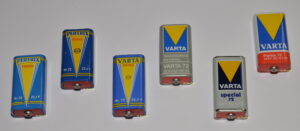Flashes and accessories
On this page I would like to present all the things that may be necessary for successful photography in no particular order.

A manufacturer unknown to me made this „TaCo pocket condenser flash“ in the early 1950s. The construction suggests that a disused, black-lacquered tin can was used for the housing. A test lamp for testing the battery voltage is available. The flash works either with flash bulbs with a bayonet socket or with an adapter with the XM1 versions. Rigid reflector screen. Battery: 22.5 volts

Zeiss Ikon Ikoflash 1 from the later 1950s. The first flash from Zeiss Ikon with a foldable reflector umbrella. (Use the red knurled wheel) The pretty design is reminiscent of a worn bar of soap, but was very popular in the days of kidney-shaped tables and petticoats. For XM flashbulbs. Battery: 22.5 volts. Test lamp for testing the battery voltage is available.

A Bodenseewerk range finder from the early 1950s. For viewfinder cameras. Sturdy metal design with automatic inclination depending on the set distance.

Haka Autoknips. For cameras without a self-timer. Is clamped to the cable release and actuates it after a clockwork has run down.

Once the film has completely disappeared into the spool, the film fix from Hama can help. Especially if you develop it yourself, a tangible beginning of the film is very pleasant.

An indispensable tool: the exposure meter. Here a Zeiss-Ikon Ikophot from the 1950s. There were different versions of the Ikophot, but what they all have in common is the beautiful design.

The Opticus is a simple slide projector of the kind that amateur photographers bought in the 1950s to torment their relatives with slide evenings. The built-in 150 watt lamp is not very bright, nor is the manually focussed 3.5/85mm lens, so that the magnification that can be achieved on the screen is limited. The slides are fed in via a drop chute.

Mechanical timer from Bäuerle & Söhne. (ca. 1960) Indispensable when working in the magnification laboratory.
Time range: 1/10sec – 60sec

Zeiss Ikon Ikoscop slide viewer. A helpful handy device for quick viewing and sorting of mounted slides. 220 volts 15 watts

Mamiya tripod type 1507 Very stable tripod that can be used up to a working height of 186 cm. Weight 4kg. Three-way panorama head with integrated spirit levels.

The Rolleikin is a kit to enable the use of 35mm film cartridges in certain Rolleiflex cameras. The assembly is quite simple, but the handling requires a little sensitivity. The image format is upright and ideal for portraits or reports with a lot of film consumption.

Agfatron electric flashgun from the early 1950s. The capacitor is charged directly via a detachable power cable. The charge is then sufficient for one to three flashes. Guide number: 20 at 21 DIN

From 1969, the VEB Uhrenkombinat Ruhla manufactured the Weimarlux CdS light meter, which did not have to hide behind West German products. Even today, the handy device still impresses with its simple operation and precise measurement results.

A polarizing filter should be used to eliminate unwanted reflections in the image. The filter for the Contarex is in a class of its own with the convenient adjustment via a knurled wheel. Note the extension factor!

The Hapo-Flash from the Photo-Porst range is one of the most beautiful flashes of the 1950s. The reflector can be folded to save space. The processing makes a dignified impression. Suitable for XM flash bulbs, battery 22.5 volts.





